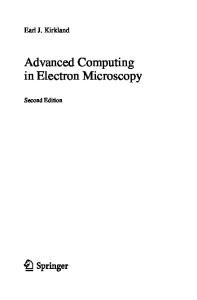High-Resolution Electron Microscopy of Quasicrystals
- PDF / 4,845,475 Bytes
- 10 Pages / 420.48 x 639 pts Page_size
- 15 Downloads / 504 Views
HIGH-RESOLUTION ELECTRON MICROSCOPY OF QUASICRYSTALS K. HIRAGA Institute for Materials Research, Tohoku University, Katahira, Sendai 980, Japan ABSTRACT I review the current results of our group about highresolution electron microscopy of the icosahedral quasicrystals, in particular, in rapidly solidified Al-Mn-Si and conventionally solidified Al-Fe-Cu alloys, by using 200 kV and 1 MV microscopes which have resolutions of .23 and .16 nm, respectively. High-resolution lattice images of Al-Mn-Si taken with the 200 kV microscope show characteristic features of a model of the three-dimensional Penrose tiling, and also show the existence of quenched phason strains and edge-type dislocations in the Al-Mn-Si and as-casted Al-Fe-Cu alloys. After annealing the stable Al-Fe-Cu icosahedral phase at 1118 K for 48 hr, quenched phason strains are almost relaxed and nearly perfect icosahedral symmetry is formed. A high-resolution structure image of Al-Mn-Si taken with the 1 MV microscope clearly shows an arrangement of the Mackay icosahedral atomic clusters. INTRODUCTION The discovery of icosahedral symmetry in sharply peaked electron diffraction patterns of rapidly solidified Al-Mn alloys by Schechtman et al. (1] led us to the recognition of a fundamentally new phase of solid matter. High-resolution electron microscopy of the same alloy taken with the five-fold symmetry axis ruled out models that explain the diffraction patterns with icosahedral symmetry in terms of large unit cell or multiply twinned crystals, and clearly showed the existence of five-fold symmetry and long-range quasiperiodicity in real space [2,3]. Also high-resolution observations of rapidly solidified Al-Mn and Al-Mn-Si alloys revealed the existence of phason strains [2-4] and dislocation defects [5] which are likely to be quenched during rapid solidification. The phason strains give rise to steps of lattice fringes in high-resolution electron micrographs [2-41 and to shifts of diffraction spots from ideal icosahedral symmetry positions in electron diffraction patterns [6]. It was also revealed that the quenched phason strains appear with a close relation to growth direction of the quasicrystal [7] . Our recent work showed that the relaxation of phason strains is so slow that even casted Al-Fe-Cu alloys include some degree of phason strains, but annealing at high temperatures leads to the relaxation of the phason strains and nearly perfect icosahedral quasicrystals without strains and defects are formed. Observed high-resolution images (lattice images) taken with a 200 kV microscope gave us much information about characteristics of lattices of the quasicrystals and lattice defects, but little information about atomic arrangements in the quasicrystals because of poor resolution and thick samples. A high-resolution micrograph ( structure image) taken with an 1 MV microscope represented directly the projection of an atomic arrangement in the quasicrystal and revealed the existence of the Mackay
Mat. Res. Soc. Symp. Proc. Vol. 139. q1989 Materials Research Soci
Data Loading...











